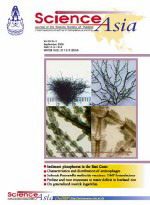ThaiScience
ThaiScience
SCIENCE ASIA
Volume 46, No. 02, Month FEBRUARY, Year 2020, Pages 213 - 223
Urban heat island analysis for bangkok multi-scale temporal variation, associated factors, directional dependence, and cool island condition
Jirawan Kamma, Kasemsan Manomaiphiboon, Nishit Aman, Tara Thongkamdee, Surawut Chuangchote, Sebastien Bonnet
Abstract Download PDF
This study analyzed urban heat island characteristics in Bangkok, observed during a period of 10 years (2006?2015) with emphasis on the dry season when the urban heat island is intensified in both daytime and nighttime as compared to the wet season. December-January was found to be the months of peak urban heat island intensity (UHII) in terms of average. The intensity is relatively large at night due to the faster cooling rate during the early evening at the rural site whose thermal admittance of land surface is lower than the urban site. UHII is slightly larger during the weekdays than the weekend, suggesting certain degree of influence of anthropogenic heat emitted in the urban area. UHII is negatively correlated with most of rain, cloud, relative humidity, and wind speed variables. The assessment of polar plots shows UHII dependence on wind direction. The statistical regression models relating UHII to selected meteorological variables are capable of explaining the variability of the original data by 82% for daytime UHII and 66% for nighttime. Southwesterly wind direction and persistence were found to be important in modulating UHII, and both appear in the final regression models. The presence of dry-season cool island events was also investigated, and it was found that they are generally induced by the high intensity of urban-alone/urban-rural rain, cloud, relative humidity, or urban wind speed (or combined). Overall, the findings from the study provide enhanced perspectives, which can support urban policy and planning related to weather for the study area.
Keywords
urbanization, temperature, urban climate, cool island, ThailandSCIENCE ASIA
Published by : The Science Society of Thailand
Contributions welcome at : http://www.scienceasia.org/
